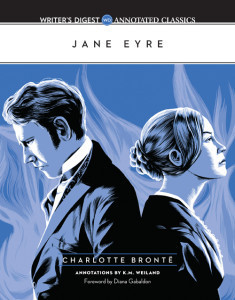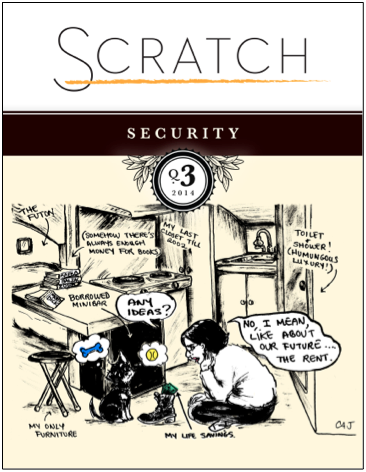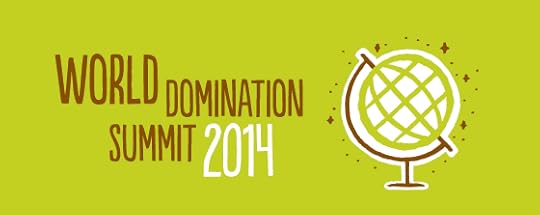Jane Friedman's Blog: Jane Friedman, page 160
August 4, 2014
Why Design Matters for Your Author Website

Photo by Andrea Costa / via Flickr
Today’s guest post is by literary agent Maria Ribas (@maria_ribas); check out her website, cooks & books.
When I was starting out as an editor, I was surprised to see just how very subjective the acquisitions process was. I think I was a little bit (well, a lot) disappointed that there wasn’t a secret equation behind it all.
Even more, it surprised me that the value of a book wasn’t communicated just by the words in the manuscript. Often, it was communicated in subtle messaging about the author: who they were, where they came from, how marketable they were—whatever that meant. That messaging became less subtle and haphazard when it happened through an author website, instead of through a query letter.
I saw how a carefully designed website often helped an author and agent control how a book should be perceived. And for practical nonfiction, which is ruled by the quantifiable platform, there were even times when the distinctive design of a website helped editors overlook modest platform numbers.
Design is your brand.
When it comes down to it, website design matters. Design is your brand. And agents and editors want to know that you’re treating your brand like a business, not like a hobby. This means that you’re willing to invest significant time and money into creating a website that clearly communicates your brand.
Think of your website like a room—the only room in your house you can show to the world. It’s sort of like a 19th-century parlour, where every item is displayed for the sole purpose of impressing visitors.
Pretend every visitor to your website is like a visitor to your parlour. What do they see when they get there? Is it a sparse room, with a standard-issue style, that looks just like the last place they were at? Or is it carefully curated, with each item contributing to the overall picture of who you are?
A website should reflect who you are, what you do, and what you care about. When done well, it can even reflect the style of your books. A writer of women’s fiction might have bright, cheery colors that mimic her book covers. A YA writer might have a hip, funky design, and a self-help writer might have a serene and inspirational look.
Your website is a blank canvas, and it can say a lot more about you and your work than a double-spaced Times New Roman, 12-point page. So make it work for you—fill that canvas with words, photos, quotes, links, and other elements that speak loudly about who you are.
Encourage lingering.
When I open up a query letter in my email, I’ll often read the first paragraph, then start scanning for a website link. I specialize in practical nonfiction, so if an author doesn’t have a website, there’s usually very little chance I can work with them (with a few notable exceptions). But these days, whether you write fiction or nonfiction, it’s essential to have an online presence. And the home base for that presence should be your website.
An effective website has clear messaging, is visually appealing, and invites the visitor to linger. A website should show agents and editors that you’ve created a place where they (and readers!) will want to spend time, get lost digging through the archives, and leave feeling inspired and connected to you.
When I open up a website that is clearly a standard-issue template, it says that the author doesn’t know how (or hasn’t yet) defined their brand. But when I open up a website and see interesting and informative articles, beautiful images, and a dynamic interface, full of ways to connect and corners to explore, I find myself lingering. I’ll start clicking here and there, reading posts, and getting lost in the author’s voice and perspective. It’s not unlike writing a compelling story—you want every visitor and every reader to get lost in the world of your website.
You have 10 seconds.
For a visitor to linger, you have to give them a reason to click away. And the truth is, you only have about ten seconds to win over an agent, editor, or casual reader when they click on your website. That’s how long it takes to assess whether this is a place to explore further, or whether it’s a one-dimensional place with little to offer.
So make sure that when your page loads, visitors are instantly greeted with something clean, professional, and visually appealing—something that looks like you. If possible, work with a professional graphic designer or branding expert if you need help defining your look. They should be able to synthesize your style, viewpoint, and goals into clear and consistent design elements.
If you want to try making improvements yourself, there are fantastic resources out there to get you up to speed—try a Skillshare class on web design or logo design (just $20), or search for upgraded or premium templates that work with your current site. Just remember to customize so that it looks like you, not like a standard-issue template.
As you start building, keep the 10-second window in mind. To create the strongest first impression, you’ll need these key elements to be above the fold (before needing to scroll):
Your website name—for an author site, this should be your name or pen name
An image, logo, or graphic element incorporated into the masthead
Social media icons
A professional looking photo of you
A tagline: What are you about? What is your mission for the site? (Here’s a great post to help you define your mission statement.)
A subscribe box where visitors can sign up to receive all your posts via email. (This is one of the best ways to stay sticky with a visitor who may be passing through for the first time.)
Page tabs: Home, About, and Contact are the essentials. Other options can include: Books, Events, Speaking, Press, Classes, Projects, Post Series, Advertise, Archive, Media Kit, Work With Me, Etc.
Remember that what will set your website apart is the sense of identity it conveys to an editor, agent, or reader. Show them something that delights them, inspires them, and excites them, and they might take a chance on you.
For design inspiration
Nonfiction: The Handmade Home, The Forest Feast, Brené Brown
Fiction: Rainbow Rowell, Maureen Johnson, Emma Straub
The post Why Design Matters for Your Author Website appeared first on Jane Friedman and was written by Maria Ribas.
August 1, 2014
Sow Your Characters’ Emotions in Early
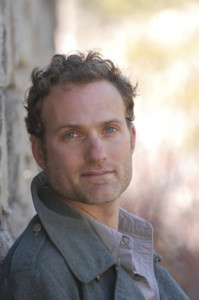
In a thought-provoking post over at Glimmer Train, Josh Weil talks about Vladmir Nabokov’s rule: If you bring a gun into the story, then it must fire by the end.
Weil reverses it to produce a new insight: “If you’re going to fire a gun at the end, you’d better bring it in near the beginning.” He goes on to discuss how the emotions that will drive action need to be seeded early:
When a character does something (say, suddenly draws a gun out of his pants waist), that action must be supported by actions that have come before; the mentality that causes it needs to be developed before the action happens. Long before.
Also this month at Glimmer Train:
Excuses, Pobrecita by Caro Beth Clark
Worrying the Culture Toward Peace by Sabina Murray
The post Sow Your Characters’ Emotions in Early appeared first on Jane Friedman and was written by Jane Friedman.
July 31, 2014
How Can Authors and Publishers Partner Better on Book Marketing? [Smart Set]
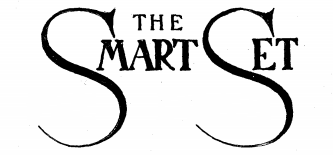
Welcome to the weekly The Smart Set, where I share three smart pieces worth reading about the publishing and media industry. I also point to issues and questions raised, and welcome you to respond or ask your own questions in the comments.
“To seek: to embrace the questions, be wary of answers.”
—Terry Tempest Williams
Publishers Need to Rethink Their Marketing Deployments by Mike Shatzkin
Industry analyst Mike Shatzkin discusses the phenomenon of accomplished, traditionally published authors who decide to self-publish due to lack of backlist and marketing support from their publishers (among other things). His commentary is one of the most lucid and reasoned arguments for why publishers need to change—dramatically and soon—how they market books. Of the two authors who recently switched to self-pub, he observes:
… [Marketing effort applied to backlist titles] can resuscitate a dormant book, and that fact, combined with the higher share of revenues self-publishing brings, can make the effort of [authors] managing their own publishing business well worth the effort to them. … Both authors want to work on making their books sell.
Of course, this constitutes a loss to the publishers whose initial efforts helped create both the product and the platform that the self-publisher and the self-publishing infrastructure (most prominently Amazon, but there are plenty of players there) then capitalizes on. …
Traits [that these self-published authors share] are marketing and publicity capability and constructive business sense. These are traits publishers should be looking for in their author partners and the fact that they can gain better expression and leverage outside a publishing house is a failing the industry really needs to fix.
Shatzkin goes onto discuss a strategic question that has not been resolved: authors need to control and manage their own online presence, but this is (of course) labor intensive. While authors could benefit from the publishers’ help, the author can’t and shouldn’t entrust that work to any single publisher. Read his full post, long but worthwhile.
Thoughts & questions:
How can publishers best support authors who can contribute to their own marketing? How do you make the partnership, as Shatzkin says, “fair and synergistic”?
You can find (my very extensive) thoughts here from a 2012 presentation: The Future of the Author-Publisher Relationship
Review of the eBook Subscription Services by Jane Litte
This is one of the first comprehensive, non-industry speak overviews I’ve seen of the ebook subscription landscape. If you’re trying to catch up on what’s out there and what sort of titles are available (or which service you might consider buying into), don’t miss this post.
Thoughts & questions:
Are you subscribing to any of the services? What’s your take on the title selection and value? Has it decreased how much you spend on books overall? (I do not subscribe to any of the services; my reading is far too niche, highly targeted, and library driven.)
A Marketing Pitch From Author Solutions by Victoria Strauss
I mainly add this as a public service announcement for anyone still not familiar with the sales tactics of publishing services company Author Solutions (ASI) and its many subsidiaries. If you are searching for a service to help you self-publish, educate yourself about the many excellent options that aren’t Author Solutions. Mick Rooney’s site is a good place to start.
Thoughts & questions:
How long will it take before ASI goes out of business?
The post How Can Authors and Publishers Partner Better on Book Marketing? [Smart Set] appeared first on Jane Friedman and was written by Jane Friedman.
July 30, 2014
The 4 Different Types of Conflict in Dialogue

Today’s guest post is by author K.M. Weiland (@KMWeiland), author of the newly released Jane Eyre: Writer’s Digest Annotated Classics.
Conflict in dialogue provides authors with one of their best opportunities for jazzing up their stories and powering their plots. Slow scene? No problemo. Just throw in a nice, heated little argument. What could be easier?
But conflict in dialogue is a little more complex than the Three Stooges would like us to think. If we keep it cranked into the red zone in every scene, readers will grow weary and, eventually, bored.
Conflict can be boring? Who knew?
On its surface, conflict seems to be nothing more than, well, conflict. But if you take a closer look, you’ll be able to identify four distinct types of conflict—all of which are necessary to create a strong and rounded story. To reach full effectiveness, conflict must be varied. Some of your scenes will require full-on red-zone confrontations, but others—depending on the featured characters and what is at stake for them—will be better served by the faintest undercurrent of tension.
In analyzing Charlotte Brontë’s brilliant classic Jane Eyre (which I discuss in-depth in my book Jane Eyre: The Writer’s Digest Annotated Classics), I discovered four different—and equally vital—types of conflict you can use to pop your story’s dialogue right off the page.
Jane vs. Helen Burns: Opposing Views, No Stakes
Early on in Jane Eyre, when Jane is still a student at the grim Lowood School for Girls, she and her best friend Helen Burns engage in a dialogue exchange that features the lowest level of conflict—that of opposing views.
In this discussion, Jane and Helen are arguing opposite perspectives about how to handle persecution. Impassioned Jane is all about defying unjust authority, while patient Helen suggests a more long-suffering and practical approach. Both characters are adamant in their beliefs, but they’re not so much arguing as they are presenting opposing viewpoints.
In this kind of conflict, the characters have little or nothing at stake. Neither of them entered the discussion with important goals. They’re not even all that invested in trying to get the other person to change her mind. The low-key conflict offers no threat to the stability of this important relationship, but still manages to give the scene the pep it would otherwise lack if both girls were simply discussing an agreed-upon belief.
Jane vs. Edward Rochester: Opposing Views, With Stakes
Conflict is created when your character wants something that is then blocked by an external obstacle—often one initiated by another character with an opposing goal. Sometimes that goal will be intangible even and unconscious on your protagonist’s part. On the outside, she will want something concrete in every scene. But the best scenes will often have a secret inner life, in which the context of the dialogue reveals something deeper at stake.
Jane’s conversations with her mysterious employer Edward Rochester are at the heart of this love story’s conflict. But in many of the scenes, Jane and Rochester aren’t at direct odds with one another. They behave as friends should: with good intentions and a desire to understand one another’s viewpoints.
But that doesn’t mean more isn’t going on under the surface.
Like Jane and Helen, Jane and Rochester often discuss moral viewpoints. Jane usually stands on the high ground of unflinching integrity, while Rochester argues for compassion and forgiveness against mankind’s erring nature. On the surface, these lively discussions seem akin to the more low-key conversations Jane had with Helen. But the crucial difference—and the reason these conversations are cranked up a notch on the conflict meter—is that both characters have something at stake.
Even when they don’t come out and state it, they’re each arguing their worthiness to be loved by one another. Rochester is arguing he should be forgiven for his past mistakes—even the current one hidden away in his attic. And Jane is arguing she deserves to be loved without having to enslave her body and spirit.
The characters aren’t arguing, in the sense that their scenes contain any kind of animosity. But the level of conflict has risen right along with the stakes.
Jane vs. the Gypsy Woman: Opposing Goals, Low Stakes
Finally, we reach our first instance of outright conflict, thanks to the fact that both characters have obvious and opposing scene goals. This next stage of conflict isn’t about the subtext (although that can still certainly play a role). This stage is about what both characters are willing to proclaim they want—and then fight for, if only in a civilized way.
Just before the midpoint of the novel, Jane encounters a strangely prescient gypsy woman (who turns out to be Rochester in disguise). The gypsy’s goal is to get Jane to admit she loves Rochester. Jane’s goal is to find out what the gypsy is really up to without giving away any information of her own.
Thanks to their opposing goals, these two characters are in conflict with each other right from the beginning of the scene. Their dialogue exchange bears little personal animosity, but neither does it bear trust. The stakes aren’t critical, but they’re blatant enough to be obviously important to both characters—and, by extension, to the readers.
Jane vs. St. John Rivers: Opposing Goals, High Stakes
When you’re ready to crank your dialogue’s conflict into the red zone, you need to check three elements off your list:
Give the characters opposing goals.
Raise the stakes.
Raise the antagonism.
In this kind of scene, your characters each want something the other is determined not to give him. Even more importantly, they want it badly. If they can’t get what they need, disasters will ensue. As a result of those raised stakes, emotions will be running high. The very fact that another character is standing in the way of the protagonist’s achieving this vital goal will likely cause the protagonist to experience some pretty heated emotions. This is where tempers flare, wild threats are made, and screaming matches ensue. Any more conflict, and your characters will abandon dialogue altogether and dive into physical violence.
Toward the end of the book, Jane engages in a passionate and desperate exchange with her final antagonist: her upright, but cold and calculating cousin, St. John Rivers, who wants her to abandon Rochester forever and become a missionary in India. As the climax approaches, Jane and St. John throw at each other everything they’ve got. They’re both invested up to their necks in their opposing goals. If Jane were to give in now, she would lose everything, including her self-respect.
High-stakes dialogue exchanges such as this one provide just as much, if not more, tension and excitement than any amount of gunplay. But, as you can see, these high-conflict scenes must be balanced throughout your story with the various levels of lower-conflict dialogue. If your highest level of conflict is going to be able to bring its full intensity to bear on readers, it has to be saved for only the most important scenes.
Pay attention to the rhythms of each dialogue exchange in your story and the importance of your characters’ goals. Craft the intensity to match the needs of each scene, and your story’s conflict will rivet readers to every page.
If you enjoyed this post, then don’t miss Jane Eyre: The Writer’s Digest Annotated Classics by K.M. Weiland.
The post The 4 Different Types of Conflict in Dialogue appeared first on Jane Friedman and was written by K.M. Weiland.
July 25, 2014
7 Industry Experts Discuss Book Marketing and Promotion
The Summer 2014 issue of Scratch (my magazine for writers) is now available. Inside, you’ll find a roundtable I hosted on book marketing and promotion, with an all-star lineup of industry folks with a wide range of experiences and viewpoints.
Here’s a little snippet, featuring Rachel Fershleiser of Tumblr, talking about the author’s role in the marketing process:
With the number of books in the marketplace, it’s going to take all of us. It’s going to take the marketing and publicity department at your publisher, your agent, your best friend, your local bookstore, librarians who love your work. It’s going to take every single person invested in your work, working together. So the author is a piece of it.
There’s this sense that this is something new, that we’re asking authors to build their own platform, and they didn’t have to before. In my experience, it’s really that you didn’t use to have the opportunity to build your own platform. So if you wanted to sell a nonfiction book, you had to already be a professor at Harvard or have a show on CNN. Or you had to have an Iowa MFA or know Lorrie Moore.
So we’re not saying you have to do something you didn’t have to do before. We’re saying you used to have to have one of six kinds of traditional platform. Now you have the opportunity to make one no matter who you are and where you are. So it’s more open, not less.
In addition to Fershleiser, the roundtable features branding expert Cindy Ratzlaff; Tim Grahl, author of Your First 1,000 Copies; longtime marketer and publicist Claire McKinney; Kathleen Schmidt, director of publicity for Weinstein Books; Maris Kreizman of Kickstarter; and Dana Kaye of Kaye Publicity.
Go read the roundtable for free. (Registration is required.)
Also free in this issue:
Baby Gotta Eat by Kima Jones—including her 2012–2014 writing expenses
an illustrated essay, What Took Me So Long, by Carolita Johnson
Interactive Graphic: Diversity in Journalism, by Vijith Assar & Manjula Martin
Real Writers’ Houses, lifestyle photos from the Scratch community of readers
The Transparency Index, where we reveal the relationships that went into putting together the issue, as well as how much money we’ve earned/spent
Letter From the Editors
Subscribers get access to the full issue, including my Contracts 101 piece on non-compete and option clauses, and my report on The Secret Life of Romance Writers.
The post 7 Industry Experts Discuss Book Marketing and Promotion appeared first on Jane Friedman and was written by Jane Friedman.
July 24, 2014
Ebook Subscription Services: Good for Authors? [Smart Set]

Welcome to the weekly The Smart Set, where I share three smart pieces worth reading about the publishing and media industry. I also point to issues and questions raised, and welcome you to respond or ask your own questions in the comments.
“To seek: to embrace the questions, be wary of answers.”
—Terry Tempest Williams
Kindle Unlimited: The Key Questions by David Gaughran
Novelist David Gaughran overviews Kindle Unlimited (KU), the new ebook subscription service from Amazon, and what it means for self-publishing authors. Self-pub authors who distribute exclusively through Amazon (through KDP Select) are allowed to participate in KU.
Note that traditionally published authors get paid differently and play by a different set of rules than indie authors.
The key questions Gaughran raises:
How much will indie authors be paid for KU borrows? It’s impossible to know right now. Also, payments for indie authors are calculated differently than for traditionally published authors.
Will KU cannibalize paid sales? Will it grow the pie? What kind of readers will it attract?
How popular will KU be?
How will this affect the algorithms? (There are already reports of KU borrows affecting the Kindle bestseller lists.)
As to whether this will be a lucrative program for indie authors, Gaughran writes:
I could see it going both ways. Those who dive in now could benefit from all those readers testing out their trial month. All those borrow-boosted books could zoom up the charts. I’m seeing some of the launch-featured books jumping from around #2,000 to #200, and general volume seems to be way up – i.e. it looks like it’s taking a lot more sales to hit the usual ranks.
Naturally, if this phenomenon continues it will squeeze out many non-Kindle Unlimited books from high-visibility spots in the Kindle Store. That would seem to make enrolling the smart move, but it’s not that simple. For starters, the first month could be a poor guide to how things will pan out – maybe most readers won’t renew their subscription when their free trial expires. And there are other considerations too.
There is really long discussion thread on this at Gaughran’s blog; read the full post and take a look.
I also highly recommend taking a look at this analysis from Publishers Lunch: Influence of Kindle Unlimited on Amazon Bestsellers Grows
For an overview of industry reaction to Kindle Unlimited, read Porter Anderson’s Bookseller piece, A Buffet of Digital Book Subscriptions.
Thoughts & questions:
The big-picture question that Gaughran raises: Does KU—or ebook subscription services in general—represent the future of reading?
Comic Sales Rise, in Paper and Pixels by George Gene Gustines
The first line of this piece in the New York Times says it all: “Print and digital may have found the ideal place to coexist: the comic book industry.” The article explores successful players and startups, and their business models. Read the full piece.
Thoughts & questions:
This is a rare glimpse of publishing good news and optimism, with business models based on subscription and pay-what-you-want. What can other magazine and book publishers learn from what’s happening in comics?
Beat Amazon! Is Not a Business Plan for Startups by Kevin DiCamillo
DiCamillo summarizes a keynote speech by Craig Mod at the Yale Publishing Course, in which he spoke at length about the qualities of Wattpad as a strong publishing startup:
The best start-ups are kinds of accidents,” Mod posits. And they are simple, too. Wattpad’s mantra seems to be “Let’s have you write something and see if some readers find you.” This “Weirdly utopian, almost naïve way of thinking” has worked well for Wattpad and has turned Allen Lau’s baby into “an infinite gold-making machine.”
Thoughts & questions:
Wattpad has been around since 2006 and is not yet profitable. (The latest reports indicate their business model may be based on native advertising.) Do you use it? What’s your take?
In his talk, Mod argued that Amazon has no incentive to change and this has led to ebook innovation stagnation. What do you think?
The post Ebook Subscription Services: Good for Authors? [Smart Set] appeared first on Jane Friedman and was written by Jane Friedman.
July 22, 2014
Writers Are Opening Up About Money—And That’s a Good Thing

Historias Visuales / via Flickr
From a recent op-ed at the New York Times:
Writers may always have worried about money, but now seems a particularly fertile time for writing about it. … This spate of talk about writing and money has opened up broader conversations about who can afford to enter the profession today, and who gets shut out.
My magazine Scratch is mentioned, and my Scratch co-founder is quoted:
Manjula Martin, the cofounder of Scratch, told Op-Talk that “there has always been this tension for writers around how to make a living and how to make art.” However, she said, growing job insecurity in writing professions and beyond may have led to a new wave of anxiety: “As the economy is changing and as things just feel more precarious in our culture, that bleeds through to the literary culture. And I think a big part of that too is a question of, ‘is literature and are the arts going to continue to be valued in ways that we have perhaps always just assumed they would be?’”
At a time when authors seem to be more divided than united, I hope we can at least agree: Sharing our publishing experiences with each other—with as much transparency as possible—helps us all make better decisions for the long term of our careers.
The post Writers Are Opening Up About Money—And That’s a Good Thing appeared first on Jane Friedman and was written by Jane Friedman.
July 21, 2014
Why I Left My Mighty Agency and New York Publishers (for now)

Olivander / via Flickr
Note from Jane: Today I’m beyond honored to feature bestselling author Claire Cook (@ClaireCookwrite), who has just released Never Too Late, from which this post is excerpted. Claire has a fascinating story to tell about her decision to leave her agency and traditional publisher, and chase after her publishing dreams.
As the ancient Greek philosopher Heraclitus said, “The only thing constant is change.”
I was cruising along, represented by a powerful literary agent from a mighty agency that I both liked and respected, published by a series of big New York publishers that believed in my books and helped me make them better, and receiving advances for my novels that were substantial enough to live well on.
And then the publishing world began to get rocky, just like the music world and the newspaper world and so many others had before it.
I was one of the lucky authors. I had multi-book contracts, I was still being sent on book tour by my publisher and published in both hardcover and paperback, so I was able to put on my blinders and ignore the changes at first. Eventually, I couldn’t help noticing my career stalling out, but I’m a glass half-full kind of person, so I just shrugged it off, and figured if I dug down deep and worked even harder than I was already working, I could make up for the shrinking energy and resources being put behind my books.
And then, after years of stability and support, it was jolting when a single one of my novels made the rounds through three separate editors, because the first two left the publishing house. I lost count of the in-house publicists disappearing through the revolving door—even their names began to blur. But the good news was that this was my final book under contract with this publisher, so I’d just find a better home for my books and myself when I was free.
When the time came, my agent and I made the rounds, meeting with editors at the big publishing houses. I signed a two-book contract with the one who promised they’d put all their resources behind me to grow my readership and to get my career moving again in the right direction.
It didn’t happen. I think they tried hard with the first book, but the things that used to work for traditional publishers trying to break out a book weren’t working so well anymore. I wrote the second book I owed them. And then I found out that their entire plan for this book was to do all the things that hadn’t worked for the first one. Even I couldn’t find the glass half full in that. So I spoke up, verbally, and then in writing, and then in writing with lots of detail, even some bullet points.
Let’s just say it didn’t go over so well. And then my editor went off on a three-month maternity leave that would end just before my book came out, leaving her assistant, a very nice young woman a couple years out of college, responsible for the care of my novel. Less than a month before my publication date, I received an email from this very nice assistant telling me she was leaving publishing to start a takeout food business with a friend.
What a coincidence, I almost wrote back. I’m leaving publishing to start a takeout food business, too!
And now no one was in charge of my book.
Oh, it was such a low point. I’d spent thirteen years trying to be the hardest working author in the universe, and I felt excruciatingly let down by the institution that was literally feeding me. And paying my bills.
It gets worse. Around this time I started receiving emails and calls from booksellers telling me they were having trouble ordering my backlist books that had been published by my last publisher. And then that last publisher went under and was bought out by another publisher who inherited all their titles. So in another huge bump in the road, these five backlist books went from being ignored to being part of a fire sale and were now owned by a new publisher that quickly demonstrated they had absolutely no interest in them.
One day right around this time it hit me: I simply can’t do this again. I cannot let another publisher break my heart.
It gets better. Independent self-publishing had taken off and grown into a viable alternative. Authors in situations similar to mine were becoming hybrid authors—both traditionally and self-published. And in this new world, there was little of the cloak and dagger stuff I’d experienced in traditional publishing where everything from money to marketing was kept secret. Indie authors were generously sharing everything they learned to help others on the same path. Via message boards and blogs and conferences, a great support system was bubbling up.
I’d already dipped a toe in this new pond, back when I first began to feel the changes. Ebooks were taking off like crazy and my readers were embracing them. Since I owned the rights to Must Love Dogs, I reformatted it and uploaded the ebook on Amazon. I gave it away on Mother’s Day to thank my readers for their support. No advertising, just an email blast, a post on Facebook and another one on Twitter. It had 32,000 downloads in that one day and reached the No. 1 spot on the Amazon free list, right next to Fifty Shades of Grey on the paid list. And now a whole bunch of people wanted to hear more from these characters. Amazing.
So the pieces of my new dream started to come together. I would find a way to get the rights to my backlist books reverted, and then I’d republish them with my own publishing company, which I’d call Marshbury Beach Books after the fictional town in my novels. Then I’d turn Must Love Dogs into a series—my readers wanted more, series were becoming more popular, and it would be fun to have a new kind of writing challenge since I’d never written a series. After that, I’d just keep writing, maybe even that nonfiction book about reinvention I’d wanted to write for years.
I hired a lawyer to help me begin the arduous process of getting the rights to my backlist reverted. But this time I did it the smart way. I reached out to a wonderful organization I belong to, Novelists, Inc., which has a legal fund for its members I could apply to for help subsidizing my efforts. NINC had a list of lawyers, and once I’d chosen one, they even made the initial contact for me.
I finished writing a draft of Book 2 of the new Must Love Dogs series. My agent not only read but also gave me helpful editorial advice. We seemed to be on the same page in terms of the steps I needed to take to get my career back on track. I’d already self-published Must Love Dogs and Multiple Choice with her full knowledge and support. It seemed to me that if I could get my career moving again, it would only benefit us both down the road.
And then one day on the phone my agent informed me that in order to continue to be represented by this mighty agency, I would have to turn over 15% of the proceeds of my about-to-be self-published book to said agency. Not only that, but I would have to publish it exclusively through Amazon, because the agency had a system in place with Amazon where I could check a box and their 15% would go straight to them, no muss, no fuss.
There was no deal, no sale. There would be no self-publishing assistance, no special treatment from Amazon to give my books an extra push, no marketing. Why would I pay 15% of my profits—forever—simply for the privilege of being represented by a big name agency? And this might well turn out to be representation in name only, since it was made clear to me that the mighty agency’s subagents could not be expected to devote time and energy to selling rights to works that were not traditionally published.
It was wrong, ethically and financially, and I just couldn’t do it. I Googled and searched message boards and was introduced to the term revenue grabbing.
To say it rocked my world would be an understatement. I was stunned, in part because I had several author friends traveling the same road, whose agents were supporting their indie journeys to get their careers back on track in a big way, and only commissioning the sales of subrights like foreign and audio.
A lawyer at another organization that I’m a member of looked over my breakup papers furnished by the agency, and told me to look on the bright side: They never would have bothered if they didn’t smell money. I was hardly a big fish at this agency, so in my mind it was more about getting caught in the crossfire as agents and publishers alike try to reinvent themselves and stay relevant in these quickly changing times.
I cried. A lot. At one point, I remember Googling Elisabeth Kübler-Ross’s five stages of grief and realizing that I was cycling through them all, from denial to anger to bargaining to depression to acceptance. And then, once I finished wallowing and being pathetic, I shook it off and got back to work, more determined than ever.
As much as this whole thing totally, totally sucked, as much as it felt like my entire support system had been pulled out from under me, I never once questioned that I would continue writing. And I never once questioned that my readers would want to read my next book, no matter how it was published.
I tell this story not to point fingers or to badmouth anyone, but in the spirit of those indie authors who have so generously shared information to help others coming up behind them on the road.
Onward and Upward
I loved having a savvy, formidable literary agent advocating for me, and a connected group of terrific subagents going after foreign and film rights. I loved working with publishing teams made up of smart people who knew how to help me make my books better and had the clout to get my books much wider distribution than I could ever get on my own.
If the right literary agent comes along, one who gets where I’m going and can support my new journey in a meaningful way, that would be great. But I’m in no rush, and it’s been both good to take a break to think about what I’ll need moving forward, as well as empowering to take control of my own career.
I consider myself a hybrid author, both traditionally and self-published. If the right traditional publishing offer comes along, especially one that would get my paper books into bookstores in a more widespread way than I can on my own, I’d absolutely work with a traditional publisher again. As Guy Kawasaki, the former chief evangelist of Apple, said about his own hybrid author career, “I’m not for sale, but I am absolutely for rent.”
But the magic for me is that I don’t need it anymore.
Jumping off the traditional publishing treadmill I’ve been on since 2000 has meant making some short-term sacrifices, the biggest of which was letting go of the money it provided. But my self-published checks come monthly, not twice a year, and I get much higher percentages of sales without sharing a percentage. The income gap is closing.
I now own seven of my twelve books. I control pricing and promotion, and I can balance my need to earn a living with making my books available to my loyal readers at the best price I can offer them. I can add fresh content and switch excerpts and change covers any time I want. By the time I have ten indie-published books, I think Marshbury Beach Books and I will be doing just fine.
But already I’m happy. Instead of waiting for the next thing to go wrong, instead of feeling like I can’t get close enough to my own career to move it in the right direction, I wake up every day and get right to work. I’m ridiculously busy, but I’m learning so many new things about writing and publishing and connecting, and I spend all day (and often a chunk of the night) doing the work I was born to do.
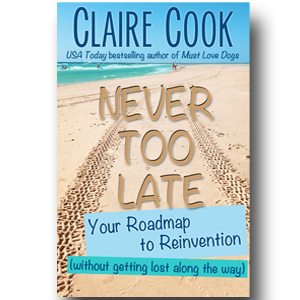 If it’s time for you to reinvent yourself like Claire did, be sure to check out Never Too Late. You can also stop by Claire’s website, ClaireCook.com, to download your free Never Too Late workbook, and to sign up for her newsletter.
If it’s time for you to reinvent yourself like Claire did, be sure to check out Never Too Late. You can also stop by Claire’s website, ClaireCook.com, to download your free Never Too Late workbook, and to sign up for her newsletter.
The post Why I Left My Mighty Agency and New York Publishers (for now) appeared first on Jane Friedman and was written by Claire Cook.
July 17, 2014
What Is the Future of the Physical Bookstore? [Smart Set]

Welcome to the weekly The Smart Set, where I share three smart pieces worth reading about the publishing and media industry. I also point to issues and questions raised, and welcome you to respond or ask your own questions in the comments.
“To seek: to embrace the questions, be wary of answers.”
—Terry Tempest Williams
The Problem of Reinventing the Bookstore by Nate Hoffelder
Over at The Digital Reader, Hoffelder summarizes and comments on several designs meant to “reinvent” the bookstore. What should a bricks-and-mortar bookstore in the digital age look like? Some ideas include the following:
Literary sommeliers who advise you on what to read next. (I think these are also called “booksellers.”)
A dedicated area specifically for events.
Comfortable reading areas, with ready access to drinks and food.
Desks that can be rented.
Multimedia interfaces in the store that allow for digital purchasing, reading of online reviews, and other “sensory” experiences.
Hoffelder says there’s just one problem with these visions:
I was disappointed by the lack of detail on the bookstores’s business models. Only one of the designs really addressed that point, and what they propose just doesn’t sound practical. The real point of this exercise was to find ways for booksellers to make more money …
Thoughts & questions:
How will physical retail bookstores need to change to remain viable businesses as more book sales shift online?
What is the future business model of the bookstore? Is it primarily based on selling books?
Platform Monopolies by Fred Wilson
Speaking of bookstores: One of the most well-known venture capitalists, Fred Wilson, has commented on the larger question raised by the ongoing Amazon-Hachette battle. He writes:
When a platform like Amazon emerges as the dominant monopoly in publishing, who will keep them honest? When every author has left the publishing house system and has gone direct with Amazon, what does that world look like? … We have invested in Wattpad, which is a bottoms up competitor to Amazon, as opposed to Hachette, which is a top down competitor to Amazon. We think its easier for a more open, less commercial platform like Wattpad to keep Amazon honest than it is for a legacy publishing house.
Thoughts & questions:
I’ll just pose a version of Wilson’s own question: When you see a dominant market power emerge (in this case, Amazon), ask yourself, “What will undo that market power?”
Will Publishing Change the Tone? by Porter Anderson
For those not closely following the news and debates on Amazon vs. Hachette, you might not realize it, but the discussion has become heated, divisive, and rather nasty. I have more or less removed myself from the conversation, except for the handful of articles I’ve linked to through Smart Set (such as the Wilson piece above).
As the dispute drags on through the summer, Porter Anderson asks if it’s time to dial it back. He writes:
How are you going to be able to take in such a high, bracing view of things if you’re trying to score points in the ground war, blog-shrieking at the 38th self-publishing romance writer from the left? … Spirited, informative, earnestly felt debate can be a huge help in such times of change and challenge. But it’s not necessary to take sides. In fact, it can be an education just to listen carefully to everyone trying to sway you.
Thoughts & questions:
There are many gray areas. Let’s acknowledge them.
The post What Is the Future of the Physical Bookstore? [Smart Set] appeared first on Jane Friedman and was written by Jane Friedman.
July 15, 2014
3 Takeaways for Writers from the 2014 World Domination Summit
This past weekend, I attended the World Domination Summit (WDS) in Portland, which attracts 3,000 creative people who are concerned with answering the question: “How do we live a remarkable life in a conventional world?” They are guided by three values:
Community
Service
Adventure
Speaking personally, I’m really into the first two, as well as the third when it’s tied to travel and experiencing new cultures. (Some of the attendees are really into physical adventure.)
The weekend was full of insightful and passionate talks by accomplished people from around the world. Here are three takeaways I was left with.
1. You don’t need to have it all figured out to take the first step.
Some creative people get tripped up and never start things because they can’t envision how they’ll tackle a seemingly insurmountable project. And they can get paralyzed by everything they don’t know. Some people want to feel safe and take action that reduces risk or feels comfortable.
With apologies to my partner, this describes his default behavior. Before tackling a project, he wants to know the process and procedure that will be followed and do everything in the correct manner. He doesn’t take the first step unless he’s researched the other steps and considered advice from experts and others with experience. He is thorough. (His day job involves scheduling and shipping logistics for hundreds of products, so he performs his job at a superior level, as you can imagine.)
I am at the other extreme. I’ll take the first step without knowing anything about steps 2, 6, and 10, then realize around step 10 that I’ve wasted a lot of time, money, or energy along the way. Sometimes this leads to failure, sometimes not.
Neither process is necessarily better (or wrong)—much depends on the situation.
However, as speaker Michael Hyatt pointed out, important things get accomplished in the discomfort zone. Attempting new things can involve hesitation and confusion—which inhibits getting started in the first place. Scott Berkun said the hidden secret that all creators have is that they have to do the work while feeling a little unsure—but doing it anyway.
What if you learned by doing, asked speaker Elise Blaha Cripe? What if you took imperfect action, asked speaker Jadah Sellner?
What if: You outline all the steps you need to take, without knowing everything at the outset, and you just focus on step 1. Then you focus on step 2, and so on. (This is a theme echoed in Anne Lamott’s Bird by Bird, as well as in Getting Things Done.) Break things down into their smallest components, and take the first step.
Besides, once you embark on a project, things change. You grow. The unexpected occurs. And you have to reframe and redirect along the way. You build in flexibility as needed to allow for what couldn’t be anticipated.
2. Write down or speak your goals to make them real.
For those who are familiar with The Secret or just the “power of positive thinking,” this advice can be construed in that manner. But that’s not the intention here.
Still, I sometimes feel conflicted when this advice is offered, depending on the context. Here are the instances when I think it is most helpful.
1. It can help clarify what you want or define what you want to do. Writing something down privately forces clarity, and seeing it on paper (or screen) is not the same as rolling it over in your head. Speaker Elise Blaha Cripe gave all attendees stickers that said, “I ____________.” It is meant to be filled in with what you do or want to be known for.
2. Writing down specific goals can help you take them more seriously and take steps to achieve them—both conscious and unconsciously. Your perspective shifts and you see opportunities to further your goal, and what is distracting from the goal. It gives you a framework for making better choices.
3. Sharing your goals publicly can bring a community to your aid. If people know what you want to achieve, they can offer resources, ideas, and assistance. If you keep quiet or don’t clearly know what you want, that obviously makes it tougher for people to be helpful. Many goals can be out of your reach without the help of others.
These themes were echoed strongly by Jadah Sellner and Elise Blaha Cripe.
Here’s when I think this approach can backfire.
Accountability. I don’t really believe in accountability partners, though many at this event did. (There were even meetups to help you find an accountability partner.) I believe in partnering with people to accomplish things, as well as critique groups, mentors, and communities. But sometimes discussing and expressing our goals publicly can be detrimental. It can de-motivate you. Read Derek Sivers’ compelling argument on this.
Magical thinking. I don’t believe things happen just because you tell the universe that’s what you want.
3. The outer shapes the inner.
If you want to become a better person, then you pretend to be a better person—because if you pretend long enough, it happens. Speaker A.J. Jacobs said, “It’s easier to act your way into a new way of thinking, than to think your way into a new way of acting.”
Yes, this is the old cliche, which works: “Fake it till you make it.”
Similarly, the way you hold your body affects your mind. If you have a Charlie Brown pose (head down, shoulders slumped), you’ll feel more sad or depressed. If you hold your head high and keep your shoulders back, it increases your confidence and lowers stress. This point was made especially clear by speaker Dee Williams, who discussed her changes in attitude and outlook by simply pretending to wear a superhero cape.
If I had to list a fourth insight, it would be from Scott Berkun, who demonstrated the role of luck in so many success stories. We tend to idolize and look for the “secrets” of how or why someone made it, while minimizing any role that chance played. He said that sometimes you can do everything right, and still fail, and that the reasons something becomes successful are often out of your control.
(Of course, not being afraid to fail—and the inevitability of failure—was a consistent theme as well.)
For those of you who have unfulfilled dreams, and need a push in the right direction to pursue them—especially if it involves starting your own business or embarking on a new career—I highly recommend WDS. I am grateful to Chris Guillebeau, its founder, for inviting me to attend. If you’ve never read his manifesto, 279 Days to Overnight Success, every writer should—plus it’s an easy way to get introduced to entrepreneurship. You should also check out The $100 Startup, his New York Times bestselling book.
The post 3 Takeaways for Writers from the 2014 World Domination Summit appeared first on Jane Friedman and was written by Jane Friedman.
Jane Friedman
- Jane Friedman's profile
- 1882 followers


